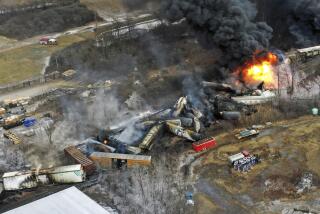Investigators Sift for Evidence at Train Derailment Site : Crash: An FBI agent says ‘we are finding’ clues at the remote area of the deadly Amtrak wreck. Cranes are used to lift cars, search underneath.
HYDER, Ariz. — Under a blistering desert sun, dozens of federal investigators got down on their hands and knees Wednesday in a painstaking search for clues along bent tracks and beneath Amtrak cars toppled in the deadly derailment of a passenger train.
“We’re looking at tracks, at bolts, at cracks, at pry marks . . . we’re looking for evidence,” FBI spokesman Jack Callahan said during a news conference at the remote crash site, about 60 miles south of Phoenix.
It was there that someone pried loose a rail and sent Amtrak’s 12-car Sunset Limited plummeting into a rock-strewn gorge early Monday.
Investigators on Wednesday continued the meticulous task of unearthing whatever evidence they could find in and around the crash site.
Two of the train’s cars that had been left standing on the tracks were towed away Tuesday. That left two locomotives, two coach cars, a partially derailed baggage/mail car and an overturned employee dorm car at track level. Thirty feet below, a sleeper car and a diner car lay on their sides in a sandy wash.
Assisted by massive cranes brought in Wednesday to lift the toppled rail cars, federal investigators crawled underneath in their inch-by-inch search for clues.
“We are finding evidence,” said Dave Tubbs, FBI special agent in charge of the Kansas City office, who is serving on a “critical response team” that now numbers more than 100 agents.
The FBI agents--assisted by experts from the National Transportation Safety Board and police officers from the Southern Pacific Railroad--fanned out across a square-mile region of desert surrounding the site in search of anything from footprints to paint chips, tire marks to lint, pausing only to refresh themselves with soda pop and sandwiches in 100-degree heat.
They also questioned cattle ranchers and cotton growers.
“We talked to everyone in the neighborhood--out here it is a very large neighborhood,” Tubbs said.
“We are continuing to comb the crime scene--the work is methodical and painstaking,” Tubbs said. “We hope to have it completed within a few days.”
But Tubbs conceded that while “we are encouraged by the progress being made . . . we are not at this point able to narrow it down as to suspects.”
The work at the crime site was part of an FBI effort that is exceeded only by the investigation into the bombing of the Oklahoma City federal building in April.
Other federal agents were following hundreds of tips phoned in from across the nation while forensic scientists studied the syntax of phrases found in a manifesto left under a rock at the crash site by a group calling itself “Sons of Gestapo.”
The one-page typed note mentioned the government sieges near Waco, Tex., and at Ruby Ridge, Ida.--both rallying cries for far-right extremists.
But federal authorities told The Times that they also are considering a theory that the derailment may have been the work of a disgruntled railroad employee familiar with railroad operations and the local geography.
“To accomplish what they did took some knowledge,” Tubbs said.
At the crash site, spikes were pried up and a rail was wedged out of alignment. A wire was used to breach the break in the rail, circumventing a system that would have switched adjacent signal lights to red, indicating that the train should stop.
One person was killed and 78 were injured--five of them critically--when Amtrak’s Sunset Limited from Miami to Los Angeles rounded a curve at 40 m.p.h. and jumped the tracks with 248 passengers and 20 crew members.
Southern Pacific Railroad officials have asked their employees to be extra vigilant at switches and signals and along main rail lines throughout the Phoenix region and across the nation.
In their widening search, federal investigators are looking at a recent article in a magazine published by the Southern Pacific Historical & Technical Society--an independent group not affiliated with the railroad company that owns the tracks at the crash site--that deals with a similar act of sabotage that occurred in the northeastern Nevada desert 59 years ago.
Twenty-five people were killed when the Southern Pacific streamliner, City of San Francisco, careened off a trestle near Harney, Nev., in August, 1939. Investigators in that case found that someone had removed spikes and forced a rail out of line.
Those responsible for what is now known as the “Tragedy at Harney” were never captured, even though Southern Pacific issued a $5,000 reward.
“Whether that article had some impact,” Tubbs said, “I don’t know.”
More to Read
Sign up for Essential California
The most important California stories and recommendations in your inbox every morning.
You may occasionally receive promotional content from the Los Angeles Times.










